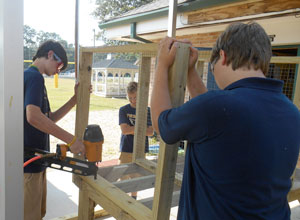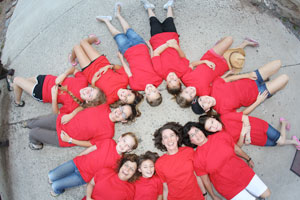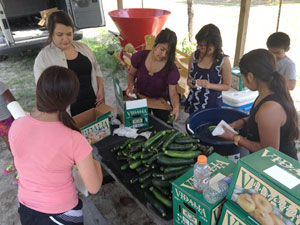Nov 18, 2014
Young Volunteers Aid, Stay Engaged In Their Communities
by Candi Helseth
Volunteerism is alive and well among America's younger generation.

As an FFA Advisor at Fifth Ward Junior High School in Bush, La., Tommy Peters has observed how volunteering has increased his students' sense of civic responsibility, improved their leadership and life skills, helped them develop parliamentary and speaking skills, and given them a heart for helping those in need. Fifth Ward FFA members raise chickens to provide eggs to low-income families and the local food bank. They also grow garden produce to give to low-income families, while teaching the younger children how to grow and harvest produce at home to supplement nutritional needs.
At HopeWest Hospice in Grand Junction, Colo., Deanna Wright, a college student who has volunteered there since high school, reflects, “I think my dad would be proud to see how I turned something awful into being a strong person who wants to help others.” Wright first experienced HopeWest's healing support at a grief group held at her school following the death of her father. She became actively involved in HopeWest's teen volunteer program, and is a recipient of the 2012 Teen Service award from the National Hospice and Palliative Care Organization.
According to Youth Helping America, 55 percent of youth ages 12 to 18 volunteer, contributing more than 1.3 billion hours of community service every year. Of those, 39 percent donate services more than 12 weeks out of a year. Youth more likely to volunteer are those whose family members volunteer and those involved in faith-based organizations. Volunteering among teenagers ages 16-19 has increased nearly 3 percentage points since 2007.
“Through our programming we have witnessed a paradigm shift in how adults view youth in their communities from those who need or require service to those who actually provide service to others,” said Michele Sullivan, National FFA Living to Serve Senior Team Leader. “Through their service-learning projects, youth feel more connected to their communities and understand the importance of service and advocacy.”
Filling a Wide Need

Youth volunteers throughout the nation fill a wide variety of slots, volunteering through faith-based, school and community outreach programs in addition to organizational programs like HopeWest's Teen Volunteers. Young people bring different energy and input to a volunteer program, HopeWest CEO Christy Whitney said. For instance, HopeWest's teenage volunteer activities include doing beauty makeovers for nursing home patients and mentoring and supporting younger children. These children, who have lost family members to death, are enrolled in HopeWest programs like Camp Good Grief! and grief groups in the schools. Teen fundraising has included events such as a prom dress exchange that offered opportunity for low-income high school girls to go to prom in style. Teen volunteers collected donated prom dresses and coordinated an event where these girls could pick a dress, new accessories, get manicures and other prom-readiness activities.
HopeWest, a nonprofit hospice, offers hospice home and facility care, palliative care, grief and caregiver support and other services relative to serious and end-of-life illnesses. Its service area covers 7,000 square miles, with two-thirds of patients living in rural or frontier communities. There are 300 employees with an additional 1,300 volunteers ages 14 to 90 that supplement services in every department and facet of the organization, according to Whitney.
FFA is among three youth community service programs under Rural Youth Development (RYD), which Congress approved in 2002. FFA, 4-H and Girl Scouts share a common purpose of engaging youth in volunteer projects to benefit their communities.
Fifth Ward's chicken and eggs project—funded by RYD, Brown Foundation, and the Fifth Ward FFA Chapter and Agriculture Department—provides sufficient funding for FFA students to raise about 300 chickens at the school farm. Peters said the students feed, water and care for the chickens and learn how to hatch and raise chicks. The chicks, along with cages built by FFA students, are donated to low-income families to raise and produce their own eggs. Students also collect, wash and grade eggs for the food bank.
“By producing and donating protein and fresh produce, students have a means of helping to ensure a balanced diet for those utilizing the local food bank,” Peters said.

In Lyons, Ga., Cadette and Senior High Girl Scouts of the Sweet Onion Service Unit implemented a nutrition program that resulted in 60 percent of participating Hispanics significantly lowering their blood glucose levels, according to Dawn Kaley, a senior manager with Girl Scouts of Historic Georgia. After learning that Hispanics' diabetes rates are significantly higher than the national average, the Girl Scouts began a campaign to teach healthy cooking and eating behaviors while respecting cultural traditions. They planted a large community garden, which annually provides more than 1,000 pounds of vegetables at no cost to program participants. They have assisted with launching home gardens, developed a cooking show, and teach mother/daughter cooking lessons on healthy preparation for traditional Hispanic foods. They also lead a girls' health and fitness troop program for elementary students. The program, now in its third year, adds new components each year.
Volunteering Offers Multiple Benefits
According to RYD, the benefits for teen volunteers include:
- developing stronger relationships and connections
- making positive contributions to their communities
- becoming more competent in evaluating, planning, managing, and public speaking
- increasing confidence in themselves as leaders in the community
- developing character, and
- learning self-regulation skills such as goal setting and goal management.
“Our philosophy with all our volunteers is that if we give them a job they love to do, they will want to keep volunteering,” Whitney asserted. “We don't ask our volunteers to do something they don't like to do, whether they are kids or adults. Our volunteers wear name tags and are treated and respected in the same manner as our employees. We give them meaningful work and recognize their contributions.”
Cole Cumming's mother was a hospice patient who died the night before his first baseball tournament. His father convinced Cole to participate in HopeWest's youth grief support program, which led to Cole's decision to become a volunteer.
“I love helping the little kids now,” he said. “I wanted to be a volunteer so I can do for others like they did for me.”
Back to: Fall 2014 Issue
